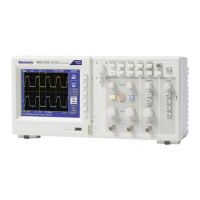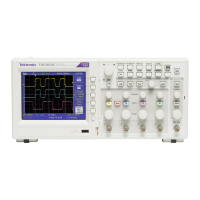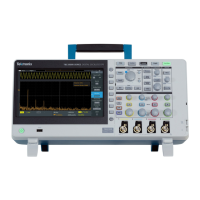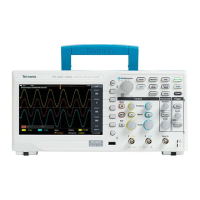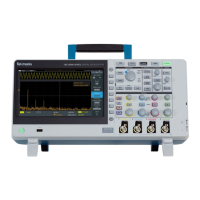Reference
The Autorange f
unction is usually more useful than Autoset in the following
situations:
Analyzing a dynamically changing signal
Quickly comparing a sequence of several signals without adjusting the
oscilloscope. This is very useful if you need to use two probes at the same
time, or if you need to use a probe in one hand and are holding something
else in the other.
Controlling which settings the oscilloscope automatically adjusts
If your signals vary in frequency, but have similar amplitudes, you can use
Horizontal Only autoranging. The oscilloscope will adjust the horizontal settings,
but leave the vertical settings unchanged. This way, you can visually estimate
the amplitude of the signal without worrying about the vertical scale changing.
Vertical Only autoranging works similarly, adjusting vertical parameters and
leaving the horizontal settings unchanged.
Autoset
When you push the Autoset button once, the oscilloscope identifies the type of
waveform and adjusts controls to produce a usable display of the input signal.
When you press the button for more than 1.5 seconds, it will perform the
Autorange function. It will displays the Autorange Menu and activate or
deactivate the autoranging function.
Function Setting
Acquire mode
Adjusted to Sample or Peak Detect
Cursors Off
Display format Set to YT
Display type
Set to Dots for a video signal, set to Vectors for an FFT
spectrum; otherwise, unchanged
Horizontal position Adjusted
Horizontal scale
(seconds/division)
Adjusted
Trigger coupling
Adjusted to DC, Noise Reject, or HF Reject
Trigger holdoff
Minimum
Trigger level
Set to 50%
Trigger mode Auto
Trigger source
Adjusted; refer to the information after this table; cannot
use Autoset on the Ext Trig signal
Trigger slope Adjusted
Trigger type Edge or Video
Trigger Video Polarity Normal
TBS1000B and TBS1000B-EDU Series Oscilloscopes User Manual 73
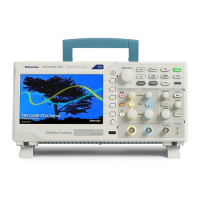
